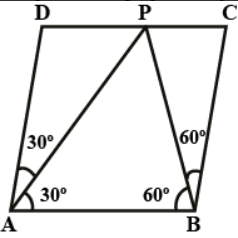In a parallelogram ABCD, AB=10cm, AD=6cm. The bisector of ∠A meets DC in E, AE and BC produced meet at F. Find the length C Foot
It is given that ABCD is a parallelogram,
in which AB=10cm and AD=6cm.
the bisector of ∠A mets DC in E.
AE and BC produce meet at F.
From the figure we have ,
∠BAE=∠EAD........(1)[∵bisectof∠A]
∠EAD=∠EFB.......(2)[a<ernate∠S]
therefore ,from (1) and (2),we obtain
∠BAE=∠EFB
∴BF=AB [∵side opposite to equal angle S are equal]
⇒BF=10cm[∵AB=10cm]
⇒BC+CF=10cm
⇒6cm+CF=10cm [∵BC=AD=6cm,opposite sides of parallelogram]
⇒CF=10−6=4cm.
therefore we get required result.
Topper's Solved these Questions
Similar Questions
In a parallelogram ABCD, AB=10cm, AD=6cm. The bisector of ∠A meets DC in E, AE and BC produced meet at F. Find the length C Foot
View SolutionIn a parallelogram ABCD, the bisector of ∠A also bisects BC at X Find AB:AD
View SolutionIn a parallelogram ABCD, the bisector of ∠A also bisects BC at X Prove that AD=2AB
View SolutionIn a parallelogram ABCD diagonals AC and BD intersect at O and AC=6.8 cm and BD=5.6cm . Find the measures of OC and OD
View SolutionIn Figure, ABCD is a parallelogram and ∠DAB=600. If the bisectors AP and BP of angles A and B respectively, meet at P on CD, prove that P is the mid-point of CD

View SolutionIn Figure, ABCD is a rectangle with sides AB=10cmandAD=5cm Find the area of EFG

View SolutionIf ABCD is a rhombus with ∠ABC=56∘, find the measure of ∠ACD
View SolutionABCD is a parallelogram and E is the mid-point of BC, DE and AB when produced meet at F. Then AF= 32AB (b) 2 AB (c) 3 AB (c) 54 AB
View SolutionIn Fig. 21, ABCD is a parallelogram, DL⊥AB. If AB=20 cm , AD=13 cm and area of the parallelogram is 100 cm2 find AL.
View SolutionIn fig. 15 ABCD is a parallelogram CM⊥AB and BL⊥AD. If AB=16 cm, AD=12 cm, CM=10 cm, find BL If AD=10cm, CM=8cm, BL=12 cm, find AB .
View Solution